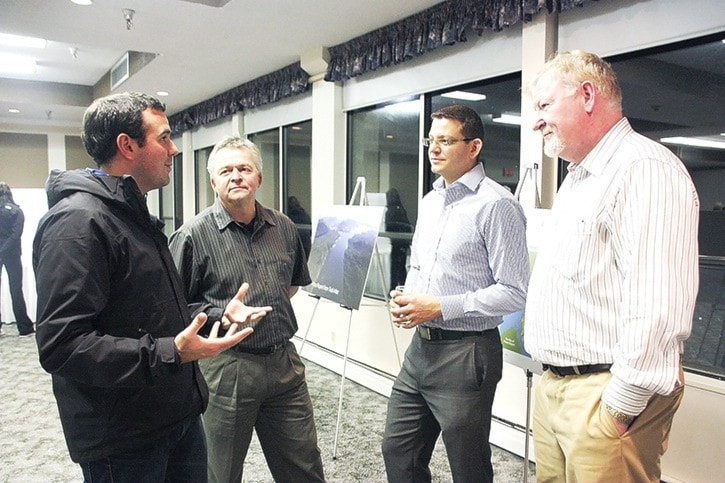Approximately 120 Rupertites attended an information session last week to hear about WCC LNG's proposed liquefied natural gas (LNG) project within Prince Rupert's municipal boundaries, with city staff, WCC representatives and environmental engineer Dr. Barb Faggetter on hand to provide information and field questions.
Discussions on the project started earlier this year when the City of Prince Rupert entered into an agreement with WCC LNG, a partnership between Imperial Oil and Exxonmobil, allowing the group to investigate the construction of a liquefied natural gas terminal on a portion of city-owned land, known as District Lot 444 (DL 444). The proponents will pay the city $18 million throughout the life of the two-year agreement, spanning from July 2014 to July 2016, with the funds being paid to the city's wholly owned Prince Rupert Legacy Ltd. in order to free them up for any purpose council feels is needed. WCC LNG has already paid a $1 million non-refundable deposit on the transfer of title to Prince Rupert Legacy Inc., and will pay another $7 million within 30 days of zoning of the site and an additional $10 million by October 2015.
WCC LNG is waiting on approval from the National Energy Board for its request for an export licence of up to 30 million tonnes of LNG per year for 25 years. The company is considering two facility concepts, a barge-mounted facility and an onshore facility, with both including five LNG trains.
A report by Prince Rupert city manager Robert Long states that if the project is constructed the city could receive up to $66 million in tax revenue annually, in addition to lease payments or a purchase payment, which could potentially take hundreds of millions of dollars off of the backs of taxpayers.
While the city undoubtedly could use the money, many in the community are worried about the effects the project could have on Prince Rupert’s watershed and airshed.
To address concerns, Prince Rupert Legacy hired Dr. Faggetter, with funds provided by the proponent, to perform a scientific review considering the impacts of using DL 444 for an LNG facility. The findings of the review were made public last week, with Faggetter providing a number of recommendations within her report.
In the airshed, the most significant emissions generated by LNG plants come from the burning of natural gas to produce energy for the plant’s compressors and electricity to run the facility. Of the pollutants created, Faggetter said nitrogen oxide would have the greatest potential of impacting the airshed, along with particulate matter to a lesser extent.
The WCC LNG facility would likely produce significant levels of both of these pollutants, with exposure having adverse affects on humans.
Based on information provided by WCC LNG, Faggetter said the onshore concept would have a lesser impact on Prince Rupert’s airshed than the barge-mounted concept.
While it was noted that B.C. air quality objectives are more stringent than before, even a short-term nitrogen oxide concentration exceedance could be troublesome.
With the facility located approximately 2.5 kilometres from Seal Cove and 5.5 kilometres from downtown Prince Rupert, certain meteorological events such as inversions or north winds could mean high concentrations in the community.
In terms of particulate matter, Faggetter reports concentration levels would likely be below the provincial criteria in the absence of any other facility. But when other proposed facilities’ emissions are combined in an attempt to evaluate potential cumulative effects, Faggetter states there would likely be exceedances, especially with the barge-mounted concept.
Faggetter said weather would have an effect on the dispersion of air borne pollutants, with winds blowing from a northward direction bringing those pollutants into the community.
“It might be expected that pollution issues in the community as a result of WCC LNG could occur approximately 24 per cent of the time, or about 87 days of the year,” reads the report.
Faggetter concludes it’s crucial the community and stakeholders work with the province to develop an airshed plan for Prince Rupert, and that using renewable energy sources in the project could reduce pollution emissions.
Nitrogen oxide is also of concern when considering the project’s impact on Prince Rupert’s watershed. Acid deposition resulting from high levels of nitrogen oxide could cause harm to the environment in a variety of ways, with Faggetter estimating the project could cause a plume as long as 74 kilometres.
Of particular concern is the project’s proximity to Shawatlans Lake, the City of Prince Rupert’s emergency water supply.
“If the acid deposition plume of the proposed WCC LNG facility is carried inland over the watershed divide, this could result in acid deposition in Shawatlans Lake,” reads Faggetter’s report.
Faggetter states Woodworth Lake is somewhat protected from any acid deposition, but there’s still a possibility during westerly winds.
Faggetter said to reduce the likelihood of using water from Shawatlans, the city should try to replace its raw water supply line before industrial development to secure Woodworth as Prince Rupert’s water supply.
Faggetter recommended both lakes’ chemistry be monitored during construction and operation of the project as a requirement. She also warned a precautionary approach should be taken by any industry that could further increase ocean acidification given the serious concerns of the B.C. shellfish industry.
There were also representatives from WCC LNG at the public meeting, providing information on field work and simulations the group has undertaken over the past few months. This has included environmental baseline work, technical investigations of the area as well as vessel navigation simulations.
While Prince Rupert city staff has recommended council approve the zoning of DL 444 with a number of conditions, the city will first hear North Coast residents’ thoughts on the project.
The City of Prince Rupert will host a public hearing at 7 p.m. at the Highliner Plaza Hotel tonight to gather feedback from residents. The hearing will begin at 7 p.m.
The report from Dr. Faggetter is available on the city’s website at princerupert.ca.
